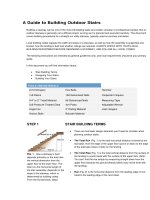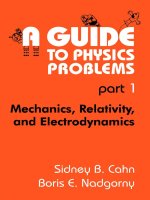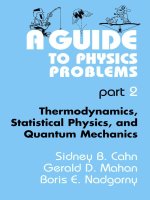A Guide to BS EN 62305:2006 Protection Against Lightning Part 1 potx
Bạn đang xem bản rút gọn của tài liệu. Xem và tải ngay bản đầy đủ của tài liệu tại đây (945.79 KB, 13 trang )
A Guide to BS EN 62305:2006
Protection Against Lightning
Furse is a world leader in the design, manufacture,
and supply of earthing and lightning protection
systems.
Over 100 years of experience makes us acknowledged
experts in the field. We provide technical support to
our customers, ranging from site visits, system design
advice, detailed application drawings and training
through to on-site supervision, testing and
commissioning.
Quality approved to BS EN ISO 9001:2000, we are
dedicated to providing cost-effective and highly
efficient products and service.
We have had a major involvement in the production
of international standards on lightning protection
over the past 15 years, reflecting the UK’s
interpretation on lightning protection, wherever
possible.
This publication offers an informative guide for
designers, engineers, architects, consultants and
contractors and has been produced with the following
aims.
● To briefly explain the theory and phenomenon
of lightning.
● To précis and simplify where possible the
British Standard BS (CENELEC)EN 62305 Parts 1-4
Protection against lightning.
All standards are open to individual interpretation.
This handbook therefore reflects Furse’s own views on
good practice and it is not the intention that these
views replace, in any way, the recommendations
contained in the BS EN 62305 series but rather to
be read in conjunction with the standard.
We hope you find this handbook useful and should
you require assistance or advice, please do not
hesitate to contact Furse at the Company’s Head
Office, at the address shown on the reverse of this
guide.
Foreword
1
www.furse.com
Contents
Author’s note and New standards on lightning protection 2
Theory of lightning 3
Characteristics of lightning
Transient overvoltages (surges)
Structure of BS EN 62305 10
BS EN 62305-1 General principles 11
Damage due to lightning
Type of loss
Need for lightning protection
Protection measures
Basic design criteria
Lightning Protection Level (LPL)
Lightning Protection Zone (LPZ)
Protection of structures
BS EN 62305-2 Risk management 21
Perception of risk
Risk management procedure
UK and world maps
BS EN 62305-3 Physical damage to structures and life hazard 35
Lightning Protection System (LPS)
BS EN 62305-4 Electrical and electronic systems within structures 69
Scope
LEMP Protection Measures System (LPMS)
Design examples 91
Country house
Office block
Hospital
Glossary and Index 113
Contents
Q06054
Various tables and Figures are reproduced with the kind permission of the British Standards Institution.
Photographs shown in Figures 4.27, 4.28 and 4.29 are reproduced with the kind permission of Elemko SA.
A Guide to BS EN 62305:2006 Protection Against Lightning
2
www.furse.com
A Guide to BS EN 62305:2006
Protection Against Lightning
Author’s note
The initial reaction from anyone reading, absorbing
and comparing this new four-part BS EN 62305 with
BS 6651 will be met with several thoughts and
emotions.
The first will be the sheer volume of information
included in the new Standard. There is approximately
4 times as much information contained in BS EN 62305
compared to BS 6651.
Secondly, part 2 – Risk management, is significantly
different from its relevant section in BS 6651.
It embraces the aspect of risk relevant to lightning in a
far more detailed and technical manner. Critics of this
part of the standard will state that it is far too
detailed and indeed too complex to have any practical
value. Only the passage of time will confirm this, or
decide that it was a major advancement in our
understanding of all the parameters needed to be
addressed when evaluating the risk of lightning
inflicted damage to humans, the structures they
inhabit and the electrical systems they use.
This new standard is a departure from all the previous
British Standards compiled on Lightning Protection.
Unlike its predecessors, this standard has been written
and compiled by many experts from all over the
world. The pure logistics of compiling so much
information and gaining consensus over many
technical points has not been easy. That is one of the
reasons why the reader with English as their mother
tongue will be somewhat confused with some of the
terminology and perhaps some of the clauses could
have been a little clearer as to their intent.
Another problem that the reader will face with the
initial publication of these standards is that not every
typographical (or in a few cases technical) error was
picked up when the IEC and CENELEC documents were
published. The strict rules within these Standard
making bodies means that National committees such
as the British Standards Institution cannot change any
of these errors when they publish their national
version of the standard.
We have, where it has been possible, corrected the
errors in this guide.
Happy reading!
New standards on lightning
protection
BS 6651:1999 Protection of structures against lightning
has been the backbone for guidance on the design
and installation of lightning protection since 1985,
in those countries influenced by British Standards.
Prior to this was BS CP326, first published in 1965.
The last 15 years has seen enormous information
gathered and ultimately an increased understanding,
relating to the phenomenon that is lightning. This
has manifested itself into a complete new suite of
standards being produced that reflects this gained
knowledge from scientists and technical people
throughout the world.
Since that 1985 publication, the UK has become more
involved with the European Union (EU), particularly
relating to standardisation. Consequently, any British
Standard now published has to be in common
agreement with its European equivalent.
The UK, as far as standards are concerned, are now
members of CEN (Comité Européen de Normalisation),
which has it headquarters in Brussels, Belgium.
The electrical arm of CEN is CENELEC (CLC) and it is the
28 European countries that constitute CENELEC, who
are responsible for compiling and producing a brand
new suite of standards relevant to lightning
protection.
It is not easy to gain consensus from differing
countries that approach the aspect of lightning
protection from different angles. Nevertheless, a
four-part suite of standards has been compiled under
the reference number 62305 series.
This four-part CENELEC Standard has now been
published. The UK’s British Standards Institution (BSI)
has taken this CENELEC standard as its own British
Standard (with minor amendments). There will be a
finite period of time when both BS 6651 and the new
BS EN 62305 series will run in parallel (this period will
be 2 years)
Ultimately the British Standards Institution will, like
all the other CENELEC member countries’
representatives, have to withdraw all their conflicting
National Standards (ie BS 6651) in favour of the EN
standard. This will occur at the end of August 2008.
3
www.furse.com
Theory of lightning
Theory of lightning
Theory of lightning
Characteristics of lightning 4
Transient overvoltages (surges) 7
Theory of lightning | Characteristics of lightning
4
Theory of lightning
www.furse.com
Benjamin Franklin (1707 - 1790) is generally
considered to be the father of modern Lightning
Protection theory. His celebrated kite experiment
proving for the first time that storm clouds
generate, hold and discharge static electricity.
Characteristics of lightning
Formation of storm clouds
Lightning is formed as a result of a natural build-up of
electrical charge separation in storm clouds.
There are two types of storm clouds, which generate a
static electrical charge, heat storms and frontal storms.
Theory of lightning
12,000m
Ice crystals
Snow
Hail
Downdraft
1,500m
Droplets
Updraft
water drops
Heavy rain
-52ºC
17ºC
Figure 1.1: Heat storm
5
www.furse.comwww.furse.com
The heat or convective storm (Figure 1.1)
predominates in tropical regions and mountainous
areas.
On a hot day, warm air rises from warm ground and is
replaced by cooler air drifting down. The convection
process progressively cools the rising air to form
clouds, first as water droplets and then at greater
heights as ice crystals.
In this way, a single or multiple cloud ‘cell’ is formed,
the top of which may reach a height of 12km.
Charge separation | Theory of lightning
Frontal Storms (Figure 1.2), which predominate in
temperate regions, are caused by the impact of a front
of cold air on a mass of warm moist air, which is lifted
above the advancing cold front. As the warm air rises
the process described above is repeated but the
resulting cumulo-nimbus clouds may, in this case,
extend over several tens of kilometres in width and
contain a large number of individual cells with heights
of between 7.5km and 18km.
Charge separation
How many clouds form is well understood. How the
cloud separates its charge is not. Many theories have
been put forward but everyone seems to agree that in
a thunder-cloud, ice crystals become positively charged
while water droplets carry a negative charge.
The distribution of these particles normally gives rise
to a negative charge building up at the base of the
cloud (Figure 1.3). This build-up at the cloud base
gives rise to a positive build-up of charge on the
ground. The ground can be as little as 1km away from
the cloud base. This build-up continues until the
voltage difference between the cloud base and the
ground becomes so great that it causes a breakdown
of the air’s resistance, thus creating a lightning
discharge.
New cloud
Warm air
mass
Heavy, cold
air mass
Figure 1.2: Frontal storm
Updrafts of
warm air
Downdrafts
of cold air
Negative
charged
cloud base
Surface rain
+
+
+
+
+
+
Figure 1.3: Charge build up in thundercloud
New clouds
130km to 525km
Warm air
mass
Heavy, cold
air mass
Advancing cold air mass can wedge warm air upward to
start an updraft at the cold front
Over-running cold front may cause storms over a wide area
++++
+
+
+
Potential is reached where a
negative downward stepped
leader leaves the cloud
+
Figure 1.4: Development of the downward stepped leader
Since these opposite charges attract each other, the
large positive charge attempts to join the downward
moving stepped leader by forming an upward moving
streamer (Figure 1.5). The two meet and form a
complete conducting path along which a massive
current attempts to flow in order to equalise the
difference in potential between cloud and ground.
This is termed the “return stroke” (Figure 1.6) and is
the bright lightning flash we see.
The lightning discharge described is the most common
seen by man and is termed a negative descending
stroke. Several variations can occur, ie from mountain
peaks or from structures. In these situations a positive
leader channel may start upward from the mountain
peak due to the intense concentration of positive
charge at that point.
Theory of lightning | Lightning discharges
6
www.furse.com
Lightning discharges
The first stage of this discharge is the development of
a stepped downward leader within the cloud, which
moves towards the ground. This downward movement
continues in approximately 50m steps. It is not visible
to the naked eye. When the stepped leader is near the
ground (Figure 1.4) its relatively large negative charge
induces even greater amounts of positive charge on
the earth beneath it, especially on objects projecting
above the earth’s surface.
Lightning strokes
As well as different types of lightning discharge,
different strokes also occur. No two lightning strokes
are the same.
Air discharges emerge from the cloud but do not
reach the ground. They can run horizontally for many
kilometres. Sometimes they re-enter the cloud base
further on, in which case they are regarded as cloud-
to-cloud discharges.
Cloud flashes take place inside the thundercloud so
that only a diffused flickering is seen. These are more
numerous than flashes to the ground and a ratio of
6:1 or more is thought probable.
Theory of lightning
+
+
+
+
+
+
Highly luminescent
return stroke
Figure 1.6: Return stroke
+++
+
+
+
+
+
+
+
Positive upward streamer
moves up to meet the strike
Figure 1.5: Development of the downward stepped leader
and upward streamer
7
www.furse.com
Transient overvoltage (surge) protection | Theory of lightning
Transient overvoltages (surges)
Structural lightning protection conforming to BS 6651
is designed to protect the fabric of the building
against lightning damage. It is not intended to, and
will not, protect electronic equipment against the
secondary effects of lightning.
By ‘electronic equipment’ we mean any piece of
equipment that incorporates sensitive electronic
components: computers, telecommunication
equipment, PBX, control and instrumentation systems,
programmable logic controllers.
To date, separate guidance on the protection of
electronic systems is given in Annex C of BS 6651.
This includes:
● An explanation of how lightning causes transient
overvoltages (surges) and the effects they can
have on electronic equipment
● Guidance on the need for protection, which
contains a risk assessment for electronic
equipment
● Methods of protection – these include bonding,
location of equipment and cabling and the use of
transient overvoltage (surge) protectors
● Advice on the selection of appropriate protectors
A transient overvoltage is a short duration surge in
voltage between two or more conductors, see
Figure 1.7. Lasting from microseconds to milliseconds
large transient overvoltages can be caused by the
secondary effects of lightning (transients can also be
caused by electrical switching of large inductive loads
such as air-conditioning units and lifts).
Figure 1.8: Cloud to cloud discharge – inductive coupling
Transient overvoltages caused by lightning can reach
magnitudes of 6,000 volts in a well-insulated power
distribution system. This is over 8 times the level
tolerated by many electronic systems.
Lightning doesn’t have to strike the building to cause
destructive transient overvoltages. The secondary
effects of lightning can cause transient overvoltages
by:
● Electromagnetic pick-up (inductive coupling)
● Differences in potential, between two connected
earths (resistive coupling)
Figure 1.9 shows two buildings. Each contains
electronic equipment, which is connected to earth
through its mains power supply. A data
communication line connects the two pieces of
equipment and hence the two separate earths.
Figure 1.9: Nearby indirect lightning strike –
resistive coupling
Lightning discharges give rise to an electromagnetic
field (see Figure 1.8). If power or data communications
lines pass through this electromagnetic field a voltage
will be picked up by, or induced onto this line.
Figure 1.7: Transient overvoltage
A nearby lightning strike will inject a massive current
into the ground. The current flows away from the
strike point – preferentially through the path of least
resistance. The earth electrode, electrical cables and
the circuitry of the electronic equipment (once
damaged), are all better conductors than soil. As the
current attempts to flow, devastating transient
overvoltages occur across the sensitive components of
the equipment.
In both cases a transient overvoltage will appear
across components within equipment at each end of
the line – the consequences can be disastrous:
● Disruption and data corruption
● Degradation of components, shortening
equipment lifetime
● Physical damage
● All resulting in unnecessary systems downtime.
These destructive transient overvoltages can be
conducted into electronic equipment by:
● Mains power supplies
● Data, signal and communications lines
Transient overvoltage protectors should be installed
on both mains power supplies and data, signal and
communications lines.
Mains power supplies should be protected
● At the main incomer or main low voltage power
distribution board
● On outgoing power supplies
● Locally to key pieces of equipment eg: computers
Data, signal and communications lines
● Protect all lines coming into the building
● Protect all lines leaving the building
Requirements for a transient (surge) protection
device:
● A low ‘let-through’ voltage (this is the voltage
which gets past the protector, reaching sensitive
equipment)
● This performance should be provided with respect
to all combinations of conductors ie in the case of
power cables, phase to phase, phase to neutral,
phase to earth etc
● Should not impair the normal operation of the
system.
What transient overvoltages are
not!
Transient overvoltages are by definition a very specific
form of disturbance. It is therefore worth briefly
outlining other forms of electrical disturbance in order
to understand what transient overvoltages are not!
Most of these disturbances can be represented as an
aberration to the normal mains power supply, shown
in Figure 1.10a.
Theory of lightning | What transient overvoltages are not
8
www.furse.com
Theory of lightning
Figure 1.10a: Normal mains power supply
Figure 1.10c: Undervoltage
Figure 1.10b: Power cut
'Outage', 'power cut' and 'blackout' are all terms
applied to total breaks in the supply lasting from
several milliseconds to many hours. See Figure 1.10b.
Very short breaks, which cause lights to flicker, may be
sufficient to crash computers and other sensitive
electronic equipment.
'Undervoltages' or 'brownouts' are sustained
reductions in the supply voltage, lasting anything from
a few seconds. See Figure 1.10c.
9
www.furse.com
What transient overvoltages are not | Theory of lightning
Nuclear electromagnetic pulse (NEMP), or
electromagnetic pulse (EMP), are pulses of energy
caused by nuclear explosions and intense solar
activity. NEMP or EMP transients are much quicker
(a faster rise time) than commonly occurring
transients. See Figure 1.10i.
Figure 1.10e: Sag
Figure 1.10h: Harmonics
Figure 1.10d: Overvoltage
Figure 1.10f: Swell
Figure 1.10g: Radio frequency interference
Figure 1.10i: Nuclear electromagnetic pulse
'Overvoltages' are sustained increases in the
supply voltage, lasting anything over a few seconds.
See Figure 1.10d.
'Sags' or 'dips' are decreases in the supply voltage,
lasting no more than a few seconds. See Figure 1.10e.
'Swells' (also called 'surges') are increases in the
supply voltage, lasting no more than a few seconds.
See Figure 1.10f.
Electrical noise or radio frequency interference (RFI) is
a continuous high frequency (5kHz or more) distortion
of the normal sine wave. See Figure 1.10g.
Harmonics are a continuous distortion of the
normal sine wave, at frequencies of up to 3kHz.
See Figure 1.10h.
10
www.furse.com
Structure of BS EN 62305
Structure of BS EN 62305
Part 1: General principles
BS EN 62305-1 (part 1) is an introduction to
the other parts of the standard and essentially
describes how to design a Lightning
Protection System (LPS) in accordance with the
accompanying parts of the standard.
Part 2: Risk management
BS EN 62305-2 (part 2) risk management
approach, does not concentrate so much on
the purely physical damage to a structure
caused by a lightning discharge, but more on
the risk of loss of human life, loss of service to
the public, loss of cultural heritage and
economic loss.
Part 3: Physical damage to structures and life hazard
BS EN 62305-3 (part 3) relates directly to the
major part of BS 6651. It differs from BS 6651
in as much that this new part has four Classes
or protection levels of Lightning Protection
System (LPS), as opposed to the basic two
(ordinary and high-risk) levels in BS 6651.
Part 4: Electrical and electronic systems within
structures
BS EN 62305-4 (part 4) covers the protection
of electrical and electronic systems housed
within structures. This part essentially
embodies what Annex C in BS 6651 carried
out, but with a new zonal approach referred
to as Lightning Protection Zones (LPZs). It
provides information for the design,
installation, maintenance and testing of a
Lightning Electromagnetic Impulse (LEMP)
protection system for electrical/electronic
systems within a structure.
Part 5: Services
This part, originally intended to complete the
five-part set, will not now be published due
to a lack of technical experts support at the
international standards committee level.
The withdrawal of part 5 impacts on some
sections, paragraphs and clauses within the
other four parts, but these references had
already been published prior to the decision
to abandon the furtherance of part 5. Any
aspects relevant to Telecoms will be covered
in appropriate ITU standards.
Structure of BS EN 62305
The British Standard European Norm (BS EN) 62305 series will consist of the following parts, under the
general title “Protection against lightning”.
The approach these new parts impart, are much wider in their view, on protection against lightning,
when assessed against BS 6651.
11
www.furse.com
BS EN 62305-1
BS EN 62305-1 General principles
BS EN 62305-1 General principles
Damage due to lightning 12
Type of loss 14
Need for lightning protection 14
Protection measures 15
Basic design criteria 15
Lightning Protection Level (LPL) 16
Lightning Protection Zone (LPZ) 18
Protection of structures 20









